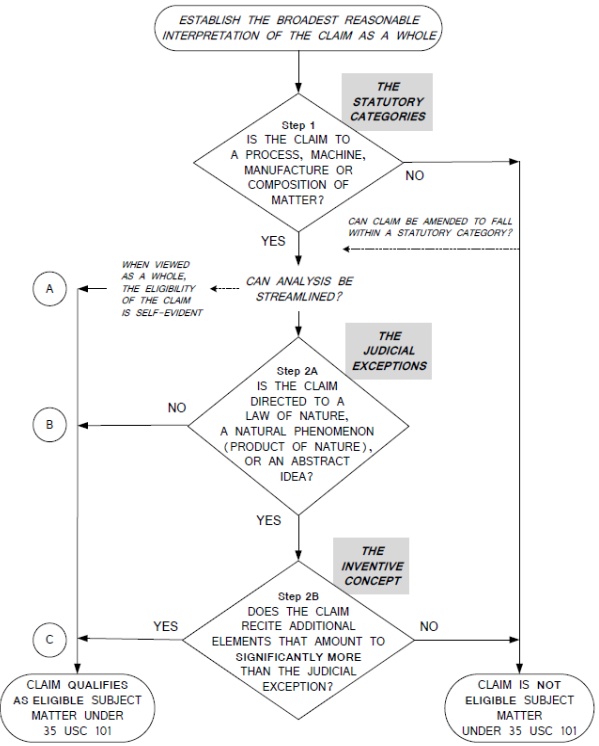IP Alerts

April 23, 2018
On April 19, the U.S. Patent and Trademark Office (USPTO) issued a memorandum to the Patent Examining Corps titled “Changes in Examination Procedure Pertaining to Subject Matter Eligibility, Recent Subject Matter Eligibility Decision (Berkheimer v. HP, Inc.).” The memorandum addresses the impact of the Federal Circuit’s Berkheimer decision earlier this year. Importantly, this memorandum presents not mere guidelines but purports to express substantive changes to the Manual of Patent Examining Procedure (MPEP) that are effective immediately and that will be formally added to the MPEP in due course. Generally, the guidelines make more stringent the factual inquiry that must underlie a finding that a claim element is well-understood, routine, and conventional, and they place the onus on the patent examiner to demonstrate this.
The MPEP sets forth the substantive and procedural rules that guide the examination of U.S. patent applications. Section 2106 of the MPEP deals with patent subject matter eligibility. That section includes the following examination flowchart to illustrate the patent subject matter eligibility process:

Steps 2A and 2B in this flowchart correspond to the so-called two-step Alice/Mayo test. The first step of the test assesses whether a patent claim is directed to a so-called judicial exception (for example, by being directed to an “abstract” idea). Testing positively in this regard leads to step 2B, where the examiner then considers whether the claim nevertheless presents other content that amounts to “significantly more” than the judicial exception itself. If the claim does contain such other content, then the claim passes muster with respect to patent subject matter eligibility, notwithstanding the presence of the judicial exception.
MPEP 2106.05(d) reflects a current understanding that making a determination about whether a claim feature presents “significantly more than the judicial exception itself” under step 2B can include a determination about whether the additional element is merely something that is a “well-understood, routine, conventional [activity] previously known to the industry.” The new memorandum from the USPTO now makes clear what the examiner must show to satisfactorily establish that a claim feature is, in fact, well-understood, routine, and conventional.
Fundamentally, the memorandum specifies that an examiner should find a claim feature to be well-understood, routine, and conventional only when the examiner can conclude that the feature is widely prevalent or in common use in the relevant industry. The memorandum sets forth four ways by which the examiner can make this showing:
- The patent application itself represents the feature as being well-understood, routine, and conventional (e.g.,, by stating that the feature need not be described in detail because it is so well known and understood). Notably, the memorandum cautions the examiner that such a conclusion cannot be based only on the fact that the application is silent with respect to describing the feature in detail.
- The examiner can cite a relevant court decision that notes the well-understood, routine, and conventional nature of the feature.
- The examiner can refer to a publication that demonstrates the well-understood, routine, and conventional nature of the feature. The memorandum cautions that this may not be as easy as it sounds. The mere fact that a publication exists that describes the feature is not enough; the nature of the publication and the description of the feature in that publication must demonstrate that the feature is widely prevalent or in common use in the relevant field. (The memorandum explicitly notes, as an example, that merely finding the feature in a single prior art patent would be insufficient unless the patent, in fact, demonstrates that the feature is widely prevalent or in common use in the relevant field.)
- The examiner can take official notice that the feature is well-understood, routine, and conventional based upon their own certain knowledge. The memorandum then notes that a patent applicant can challenge such a notice, in which case the examiner must then either respond with a showing under one of the first three options noted above or by providing an affidavit or declaration that sets forth specific factual statements and explanation to support this position.
Patent applicants will likely welcome these specific changes to the examination process. Although this memorandum does not address step 2A of the above-described examination process, the memorandum does clarify what exactly an examiner must present in order to support a finding under step 2B that a claim feature is well-understood, routine, and conventional, and it further clarifies that it is the examiner who has the responsibility to show it.
For more information, please contact Fitch Even partner Steven G. Parmelee, author of this alert.
Fitch Even IP Alert®


